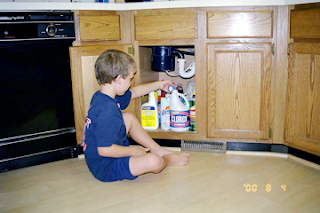"Pesticides were identified as the ninth most common substance reported to poison control centers, and approximately 45% of all reports of pesticide poisoning were for children." [1]
Further,
"An EPA survey showed that almost half (47%) of households with young children and 75% of homes without young children had pesticides stored in unlocked cabinets within reach of children." [2]
Pesticides are chemicals that kill or
otherwise control pests. They can be either synthetic (man-made) or organic (naturally-occurring).
Both types can be toxic to people.
Common
household pesticides include:
Ÿ
disinfectants and sanitizers
Ÿ
products used to remove mold and mildew
Ÿ
cockroach and ant baits
Ÿ
insect repellents
Ÿ
pet products that control fleas and ticks
Ÿ
herbicides (i.e., weed killers)
Ÿ
pool chemicals
Preventing pesticide poisoning in the home
begins with safe storage practices. Avoid stockpiling pesticide products. Buy
products in quantities that can be used in a short period of time. Remember
that many common household cleaning products and disinfecting agents are, in
fact, pesticides. Consequently, homeowners often inadvertently store household
pesticides in kitchens and bathrooms. Read pesticide labels carefully for safe
storage recommendations. Every pesticide label will alert the user to, “Keep
Out of Reach of Children.” Remove any pesticides from under sinks, in vanities,
or on garage benches and place all pesticides out of reach of children in a
designated, locked cabinet or one equipped with a child-proof safety latch. Always
store pesticides in their original labeled containers and never transfer them to food or drink containers.
Exposure to pesticides can also happen during,
and even after, application. Consider purchasing ready-to-use pesticides rather
than concentrates. Select low toxicity pesticide products labeled “Caution” on
the front panel and read and follow label instructions. Move children, their
toys, and pets out of areas where pesticides will be used. Keep them out of
treated areas until the pesticide has dried (or according to label instructions).
Ventilate treated rooms before re-entering. When treating pets with flea and
tick products keep them away from children until the product has completely
dried
Improper insect repellent use is another often
overlooked source of pesticide exposure. Never
over-apply insect repellents to yourself or others. Repellents are intended for
use on exposed skin and clothing. Do not apply repellents under clothing or
onto cut, bruised, or irritated skin and do not apply onto the face or hands of
children.
Always close pesticide containers tightly
after use and make sure to use child-resistant packaging correctly (e.g., fully
engage cap mechanisms). Never leave
an open pesticide container unattended. Finally, and just in case, post or
program the Poison Control Centers’ national hotline telephone number, (800)
222-1222 to your personal phone.
For more information about safe pesticide use
around the home, visit:
Ÿ
Purdue Pesticide Programs at http://www.ppp.purdue.edu/
Ÿ
National Pesticide Information Center at http://www.npic.orst.edu/
Ÿ
Environmental Protection Agency (EPA) at http://www.epa.gov/pesticides/
Photos courtesy of pesticidepics.org
-Drew Martin, Curriculum Development Specialist
Purdue Pesticide Programs
[1]
Roberts, J.R. & Karr, C.J. (2012). Pesticide Exposure in Children. 130 (6).
Abstract retrieved on-line, March 11, 2013,
at:www.ncbi.nlm.nih.gov/pubmed/23184105
[2]
National Pesticide Information Center: Poison Prevention. Retrieved on-line,
March 11, 2013, at: www.npic.orst.edu/health/poisonprevent.html.


No comments:
Post a Comment